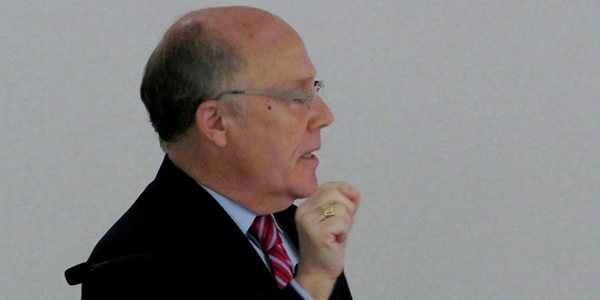By Rich Heidorn Jr.
WASHINGTON — Physicist Mark P. Mills gave the NERC Reliability Leadership Summit a blistering and entertaining critique of green tech punditry, saying forecasts of a rapid shift away from hydrocarbons are delusional.
Mills, senior fellow at the conservative think tank the Manhattan Institute, said the big challenge for green technology is the scale of hydrocarbon use — 80% of world energy — and its superior energy density.
“If all of the hydrocarbons that we consume were actually in the form of oil … and we divide them up into barrels, those barrels would go from here in D.C. to [Los Angeles],” he said in a keynote speech. “And the barrels would grow in height at the rate we consume it by one Washington Monument every week. That by itself demonstrates how fatuous it is to talk about ‘moon shots’ to change a system like this. Putting a few people on the moon a few times is an amazing engineering achievement. [But] it’s not a transformation of anything. Transforming and changing how society uses energy is like putting all of humanity on the moon — permanently.”
Mills said those who predict Moore’s Law-scale performance improvements in renewables are making a “category error” in conflating energy technology with digital technology. He cited as an example an International Monetary Fund working paper, “Riding the Energy Transition,” on the potential of electric vehicles to cut oil consumption, which stated “Smartphone substitution seemed no more imminent in the early 2000s than large-scale energy substitution seems today.”
“The biggest energy revolution in terms of how we use energy is unequivocally what we’ve done in computing. Nothing like this has every happened in the history of humanity,” Mills said. “If today’s iPhone had 1980s energy efficiency, that iPhone would be taking the electricity of a Manhattan office building. If a single data center operated at 1980 energy efficiency, one data center would require the entire output of the U.S. on the grid.
“But analogizing information-producing technology with energy-producing technology is a fundamental category error. It’s much worse than comparing apples to oranges. It’s even worse than comparing apples to ball bearings. The difference in the physics between information-producing and energy-producing is deeply profound. If energy systems could scale like computing systems, a single postage-stamp size solar array could power the Empire State Building.”
“That … will … never … happen,” he said, pausing for emphasis with every word. “It happens in comic books. It’s science fiction.”
Mills said the aspirational targets of green tech supporters is based on the notion that wind, solar and battery technologies can make 10-fold gains in efficacy.
“The last few decades, we have seen 10-fold gains in the fundamental efficacy of wind, solar and batteries. But another 10-fold [improvement] is not going to happen. Solar technologies are now approaching underlying physics limits.”
Wind turbines are also closing in on Betz’s law, which states that no turbine can capture more than about 60% of the kinetic energy in wind. “The best wind turbines are now pushing 45% efficiency. … It’s a hell of an achievement,” Mills said. “There’s no 10x left. We’re done.”
Batteries have more headroom for improvements but still face fundamental limits, Mills said.
“There is 1,500% more energy available in a pound of oil than in the best pound of battery chemistry. That’s a big gap. There’s no physics known to close that gap. If you want hydrocarbon class energy density, you would invent oil.
“Now the electrochemistry of batteries is going to get a lot better. There’s a lot of cool stuff on the horizon.”
But the cheapest batteries are currently six times the cost per kilowatt of natural gas generation, Mills said. Even if they reach the “aspirational goal” of two to three times gas-fired generation, batteries won’t be able to replace gas-fired generation on cost.
Mills said there is actually more room for efficiency improvements in shale gas extraction, which he called “under-engineered” despite improvements in horizontal drilling and fracking. Mills has put his money where his mouth is: He is a strategic partner with energy-tech venture fund Cottonwood Venture Partners, whose portfolio consists entirely of companies serving the oil and gas industries.
He did not say whether he still holds to the views of the Greening Earth Society, a now-defunct petroleum industry-backed organization that opposed EPA’s regulation of CO2 as a pollutant, insisting it was “one of nature’s most fundamental building blocks.” Mills was among the group’s scientific advisers.
Mills said policymakers concerned about climate change should support funding of basic science that can result in breakthroughs rather looking for incremental improvements to existing technologies. “You didn’t get the car by subsidizing the railroads,” he said.
“The world has spent $2.5 trillion in 20 years on nonhydrocarbon energy forms. And the world has reduced its use of hydrocarbons as a percentage of consumption by 1.5 percentage points. And we use 150% more hydrocarbon than 20 years ago.
“My policy recommendation is … take most of the money that we’re using to subsidize yesterday’s stuff — and I mean wind turbines, yesterday’s batteries — and put half of it back in the Treasury for deficit reduction and the other half give to basic science, because that would be a 10-fold increase for basic research.”





